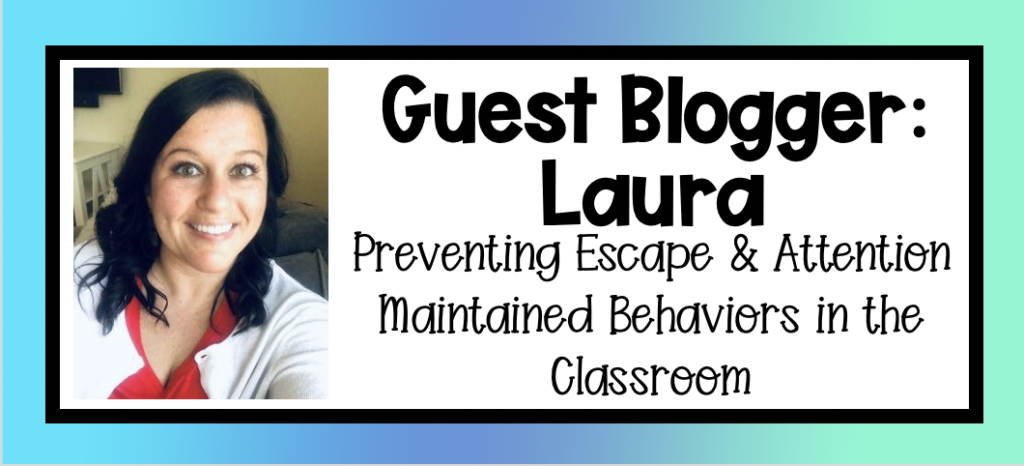I’m so excited to introduce this week’s guest blogger, Laura from Behavior Stuff with Scrap! She is here to talk all about how to Prevent Behaviors in the Classroom!

Hi! I’m Laura Aleszczyk from @behavior.stuff.with.scrap. I’ve been a special education teacher for 10 years (behavior self-contained) and a BCBA since 2018.
Needless to say, I’ve seen my fair share of behaviors maintained by attention, escape, or in many cases… both! Today I want to share my favorite tips with you to prevent behaviors from occurring in your classroom.
Non-contingent reinforcement is used at set time intervals, and doesn’t require specific behaviors to occur before reinforcement is provided. The key is to pay attention to baseline data. Be sure to use NCR PRIOR to the behavior occurring.
So, if your baseline data indicates the problematic behaviors are occurring every 10 minutes, you may want to provide the attention/option to escape every 8 minutes.
For attention, it may look like a smile, a high five, a conversation, etc. The more you can give the student with attention, the less likely they will be to engage in attention seeking behaviors. For escape, try providing breaks on a set schedule.
Oh, choices…I could go on for hours about the benefits of offering choices. In fact, I have- in meetings, trainings, podcasts, random conversations where I can bring up offering choices, etc. It is probably the most frequent strategy used in my classroom to prevent escape from demands. Choices can be used in any setting!
For now, I’ll just give you the basics. When you are offering a student choices, try to stick with 2 clear options. The options typically shouldn’t disrupt the completion of a task. The chosen option should satisfy both you and the student. Offering locations, different writing utensils, who to complete it with, the order it is completed- all great options. For example, you may say to a student, “Time for math! Do you want to work at your desk or the bean bag?”.
This does not indicate that skipping math is an option, but it does allow for the student to have some control and hopefully more enjoyment when choosing where they can sit. When the student decides, this is the perfect opportunity to provide attention for using their words, making a decision quickly, or whatever other behavior you want to see continue!
It is important to teach our kids that it is easier to complete a task than to engage in problem behavior. Consider helping them get the task started. Saying, “Thanks for sitting down with me! Do you want me to write the name or date for you?”, can show your student that you are there to help- in fact, it even appears you are doing the work for them!
(Ahem, also another opportunity to provide choices)
Perhaps the student does all the hard work to solve a math problem, so you are willing to write down the answer for them. Initially, you can also either adjust the number of problems or time required to work on the task, and gradually increase those.
FCT is a strategy you can use to help the students communicate effectively rather than displaying problematic behaviors. In this case, you may want to teach your students to request attention, help, or to request a break. Initially, any time the student communicates or tries to communicate appropriately with you, the break or attention should be provided immediately.
Even teaching the student to say, “I don’t want to do this!” is an acceptable response as opposed to them engaging in maladaptive behaviors. An assignment pass is also something you can offer students when you are first shaping up their behavior to accept and complete demands.
Depending on the intensity level of their behaviors, you may want to offer more than just one. As the student has success, these supports can be faded out. For example, if you start with students having 3 assignment passes daily, consider reducing down to 2 the following month.
When using an assignment pass or teaching a student to request to skip an activity, remember that it isn’t permanent! You will be teaching the student that it is less effort for them to communicate appropriately, then it is for them to engage in off-task behaviors.
Hope you’ve been able to take a few things away on how to Prevent Escape & Attention Maintained Behaviors in the Classroom!
Also, make sure to read How to Make Your Classroom a Safe Space!
You can also read about all the ABA Assessments here!
Instagram | TeachersPayTeachers | Facebook | Boom Learning Library | Pinterest | Youtube
What are you looking for?
COPYRIGHT © 2025 Full SPED Ahead